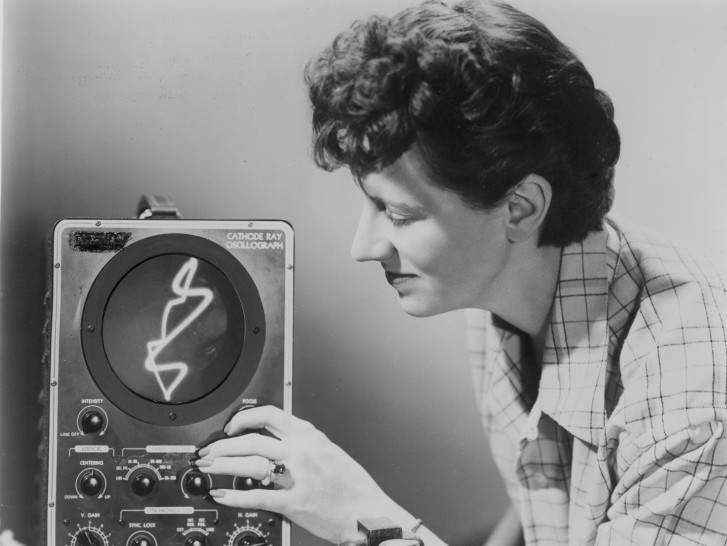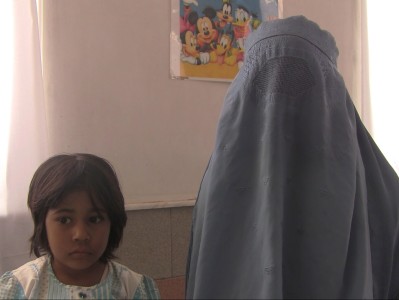
Seeing Sound. A Mary Ellen Bute Retrospective, introduction by Haden Guest and Cindy Keefer.
Transcript
John Quackenbush 0:00
September 29, 2014 Harvard Film Archive screened works by Mary Ellen Bute. This is the audio recording of the introduction by HFA Programmer David Pendleton and Cinema for Visual Music Director Cindy Keefer.
David Pendleton 0:19
Good evening, ladies and gentlemen. My name is David Pendleton of the Harvard Film Archive. And it's a pleasure to welcome you to the second of two evenings that we have featuring holdings from the Center for Visual Music. Tonight, the work of Mary Ellen Bute, a woman who is known as sort of a pioneer in what's called visual music or abstract animation, but whose work is read about more often than seen. Her best-known work, of course, is Spook Sport, but that gets seen largely in the context of retrospectives or tributes to Norman McLaren. So we're very pleased to be able to present a full program of the work of the remarkable Mary Ellen Bute. And we're able to do so, as I said, thanks to the work of another remarkable woman, Cindy Keefer, from the Center of Visual Music, who curated this program, and who's here to introduce it. Before I introduce her, let me just ask that you please turn off any devices that you have on your person that might make noise, or shed light, or record images off the screen. We would greatly appreciate that. The woman that I'm about to bring up to the podium is Archivist and Curator at the Center for Visual Music, which distributes, and preserves, and restores abstract animation, various kinds of abstract, moving image work, such as that which is called “visual music.” She was here not that long ago, when we had a Jordan Belson program, as well as last night's Oskar Fischinger program. And we're very welcome, we're very grateful to have her back. And I ask you now to welcome Cindy Keefer.
[APPLAUSE]
Cindy Keefer 2:17
Thank you, David. And I want to thank Haden, Brittany, and all the others at Harvard Film Archive that made this program possible. And I do need to thank Cecile Starr, the film historian who for many decades, kept Bute’s work available as her official distributor, who knew her well, and wrote quite a bit about her. So we do present this show in association with her.
Speaking of Center for Visual Music and programs, so are the Belson fans that were here last night, here tonight? Because I want to mention that in New York, November 16, we have a little mini-program during MoMA’s Festival of Preservation. So we have four films playing November 16 at MoMA, including Jordan Belson’s rare LSD. So if you want to see that in newly preserved film, that's MoMA, November 16. And we're also showing the Fischinger Study Number Five, from last night. And the two newly discovered John Cage films, which we preserved: the long-lost, thought lost, recently found in a Long Island storage locker, two films by John Cage, and he physically edited one of them himself. He wrote the score for the film, not the soundtrack. There is no soundtrack, it's silent. Anyway, enough about him. Let's go back to CVM and Bute. But that's November 16, again.
So CVM is a nonprofit archive, located in Los Angeles, dedicated to visual music, experimental animation, and abstract cinema. Our major collection is the work of Oskar Fischinger, but also Jordan Belson, and others in the history of visual music, particularly those influenced by Fischinger, such as Mary Ellen Bute. And we do have the world's largest collection of visual music resources. We have the papers of Oskar Fischinger, his films, most of his surviving animation process materials, and the original research library of animation historian William Moritz. This is in a small research library in L.A., but there are great resources online. We do, in fact, have a Mary Ellen Bute research site, with a great amount of information, huge bibliography, some articles, biographies, etc, etc. So that's centerforvisualmusic.org. Just go to the artists’ pages. So our programs include preservation of significant films of the genre, and our programs and films are featured in museum exhibitions, cultural centers, archives, and cinematheques worldwide. We do produce DVD compilations, as David mentioned. There's a few of the Fischinger DVDs here tonight, if anyone's interested. We continue to make the work available through other access programs such as exhibitions, and we have a new Fischinger book, which is available online at pretty much everywhere distributed by Thames and Hudson.
So we keep mentioning this word “visual music,” and Mary Ellen Bute does fall in this tradition. But what is this? Some of you were here last night, and I'm sorry, you're going to hear a couple repeats. There's 100-year history of visual music, and a bibliography stretching back centuries, the number of definitions expanding as the field grows rapidly. Some of the classic definitions of visual music come from film historian William Moritz: “A music for the eye comparable to the effects of sound for the ear.” He wrote about artists’ desire to create, with colored light and film, a moving abstract image as fluid and harmonic as auditory music. He asked, what are the visual equivalent of melody, harmony, rhythm, and counterpoint? Mary Ellen Bute, however, used the words “seeing sound.” And there's some fantastic titles at the heads of some of her films, about this phenomena of seeing sound, that we'll see very shortly here. Actually, one of the first uses of this term “visual music” in English, describing a film, was in Bute’s late 1930s advertisements for her films. Before that, “visual music” had been used to describe painting, but only in a couple of art history volumes, and it was not a widely used framed, uh, phrase. Bute’s press releases advertised her “seeing sound” films as visual music, that they combine science and art to create “seeing sound.” And very early in her career, she wrote that her goal was much more than just a visual interpretation of music. It was to make an interrelated composition. In 1936, she said in an interview, “We need a new kinetic visual art form, one that unites sound, color and form. We can take a mathematical formula and develop a whole composition, exactly synchronized, the sound and the color following a chromatic scale. Or we can take two themes, visual and aural, and develop them, at times, in counterpoint.”
Bute lived 1906 to 1983. Born in Texas. She was one of the first female experimental animators in America, and one of the first abstract filmmakers in the United States, a pioneer of electronic art and music visualization. So tonight, we're seeing her series of 14 abstract films, which she made before she moved on to live action filmmaking. Most notable is her live action feature film, Passages from Finnegans Wake, which has recently been restored by Yale. Many of her short abstract films played at Radio City Music Hall in New York, a major cinema of huge proportions, thousands of seats, beginning in the 1930s. First, a note about tonight's program. The print quality varies widely. These are 16 millimeter prints, there are some brand-new, preserved prints, and there are some much older, worn, spliced, distribution prints. And there's even one or two that are a bit faded. Many of Bute’s 35 millimeter originals are lost, and other bits and pieces are spread across multiple collections and archives, making preservation of her work especially difficult. I will mention that these films were all originally made in 35 millimeter. We're screening 16 millimeter prints tonight. Most of these come from the collection of film historian Cecile Starr. CVM is now taking over the distribution of Bute’s work from Cecile Starr, who has done it for decades. Bute entrusted her with her prints and her work. So they are, it is a wide variation in quality. There is one digital, the last one is digital, because there is no film print available.
Some of you may know Cecile’s writing on Bute, or her seminal text, Experimental Animation. Some of her text, Bute’s writing, and other articles and essays, are on our Bute research site, as I mentioned. Visit the artist’s page on our website. So Bute was born in Texas, originally trained as a painter, studying at the Pennsylvania Academy of Fine Arts and the Sorbonne in Paris. She studied stage lighting and then stage production at Yale. When she first saw Kandinsky paintings, like many others at that time, she was inspired to bring movement to her own paintings, but she didn't know how. So she explored, will possibly through some kind of optical instrument? Through color organs? But finally after a period of experimentation in New York, her path finally led her to film. She worked with the Russian inventor Leon Theremin, and presented a paper with him in 1932 at the New York Musicological Society, The Perimeters of Light and Sound and Their Possible Synchronization. She studied Joseph Schillinger’s mathematical basis of musical composition, and made a short, unfinished film experiment with him, Synchromy, in 1933. She also briefly assisted a major color organ artist, Thomas Wilfred.
Bute, like many artists of her era, was influenced by the abstract animated films of Oskar Fischinger. She wrote that during the Schillinger period, she was studying the complex mathematical correspondences between music and visual structures. But one day, she just took off and went to the movies to relax. There was a short playing before the main feature, and that short was Oskar Fischinger’s Study Number Five, set to jazz. Bute remembered, quote, “It was the simplest thing, drawn lines fluttering about in graceful swirls, in perfect time to the music. Suddenly, it all made sense to me. That was how to do it, not by mathematical theories, but rather an intuitive choreography.” So in her film, Color Rhapsodie, which we'll see tonight, you can especially see Fischinger’s influence. So briefly, I will read you a few program notes from 1956, from the Ted Nemeth Studios. Ted Nemeth was her cameraman, who later became her husband. So in a lot of the films you'll see, “Produced by Ted Nemeth Studios, a film by Mary Ellen Bute.” I do want to be clear that Mary Ellen was the director on these films, and the animator. There are some people today that try to credit these films to Mary Ellen Bute and Ted Nemeth, but I think that comes from a terrible tradition, believing that a woman couldn't have made these films in 1930, by herself. However, she was rightly the director of all these films, even though some have a producer credit, by Ted Nemeth.
So their program notes explain the films may be divided into the following five categories. One: Prefabricated forms, entering and exiting the field of vision through various cinematic devices, such as stop motion, skip frame, cuts, fades, dissolve, zooms, etc. Examples are some of the first few films, Rhythm in Light, and Parabola. Two: Drawing on film by hand, combined with photograph patterns, such as in Tarantella and Spook Sport. Three: Color by interference, optical devices, prisms, etc, such as Escape and Pastorale. The animation or cartoon technique, the examples Polka Graph and Color Rhapsodie. Five: Electronically generated figures combined with hand-drawn backgrounds. Those are the last two films. The electronically generated figures are from an oscilloscope. Bute would feed the soundtrack through the oscilloscope, film the oscilloscope, then animate that, in layers, back with other imagery set to the same music. So these are the last two films, Abstronic and Mood Contrasts.
A couple more notes. Let's see. Dada (1936) was made because she saw one of Fischinger’s films used in a Universal newsreel, that was Study Number Five, distributed all over by Universal. So she contacted Universal to see if they'd use one of her films. They said yes, but there's a time limit. So she made this very short film for them, for Universal newsreel, Escape. When Norman McLaren saw this in 1938, he said, “It was the best abstract film I've seen.” These are just some of the early films I've just mentioned.
The next group is her mature, hand-drawn animation period. Spook Sport, for which she hired the animator Norman McLaren. However, the film is hers. She is the director of this film. Online, you will see plenty of places that attribute it to Norman McLaren, but he was a hired animator on this film. Her work did turn out to be quite an influence on McLaren. And I'm happy that this is a brand-new print. Polka Graph is an old and very faded print, and it is very difficult to obtain any other source, unfortunately. This is 1947, and won a Venice Film Festival Award. Color Rhapsodie, one exhibitor advertised this as “an exciting new Technicolor novelty,” and this one is a pure homage to Fischinger. Imagination has a little bit at the beginning. There's the very end of a Pyramid Films Distributors logo visible at the front. It was erroneously printed over the beginning soundtrack, we can't remove it. So ignore that little jump at the front of Imagination. New Sensations in Sound is one of my favorites. It was a 1949 RCA commercial. It was not shown in theaters or television. It was an ad for color television, for in-house RCA sales conventions. And Mood Contrasts, the film that you'll see tonight, is a combination of two earlier experiments, one originally called Mood Lyric. Best Short Film at the 1958 Brussels International Experimental Film Festival. One final quote about Abstronic, from the press release from Ted Nemeth Studios: “These electronic pictures of the music are natural phenomena which take place in the subatomic world. They are then captured on the cathode-ray oscilloscope, and filmed with the motion picture camera. The colored backgrounds are hand done, and superimposed on the electronic animation of the musical themes.” So I do encourage you to go and look at the research site to learn more about Mary Ellen Bute. And in the meantime, thank you, and enjoy the films.
[APPLAUSE]
©Harvard Film Archive
Related film series
Explore more conversations
Yoshida Kiju & Okada Mariko

Zhao Liang

David Gatten

John Gianvito & Soon-Mi Yoo

